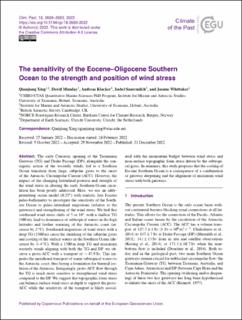| dc.contributor.author | Xing, Qianjiang | |
| dc.contributor.author | Munday, David | |
| dc.contributor.author | Klocker, Andreas | |
| dc.contributor.author | Sauermilch, Isabel | |
| dc.contributor.author | Whittaker, Joanne | |
| dc.date.accessioned | 2023-02-17T08:35:32Z | |
| dc.date.available | 2023-02-17T08:35:32Z | |
| dc.date.created | 2023-01-15T15:07:26Z | |
| dc.date.issued | 2022 | |
| dc.identifier.citation | Climate of the Past. 2022, 18 (12), 2669-2693. | en_US |
| dc.identifier.issn | 1814-9324 | |
| dc.identifier.uri | https://hdl.handle.net/11250/3051795 | |
| dc.description.abstract | The early Cenozoic opening of the Tasmanian Gateway (TG) and Drake Passage (DP), alongside the synergistic action of the westerly winds, led to a Southern Ocean transition from large, subpolar gyres to the onset of the Antarctic Circumpolar Current (ACC). However, the impact of the changing latitudinal position and strength of the wind stress in altering the early Southern Ocean circulation has been poorly addressed. Here, we use an eddy-permitting ocean model (0.25∘) with realistic late Eocene paleo-bathymetry to investigate the sensitivity of the Southern Ocean to paleo-latitudinal migrations (relative to the gateways) and strengthening of the wind stress. We find that southward wind stress shifts of 5 or 10∘, with a shallow TG (300 m), lead to dominance of subtropical waters in the high latitudes and further warming of the Antarctic coast (increase by 2 ∘C). Southward migrations of wind stress with a deep TG (1500 m) cause the shrinking of the subpolar gyres and cooling of the surface waters in the Southern Ocean (decrease by 3–4 ∘C). With a 1500 m deep TG and maximum westerly winds aligning with both the TG and DP, we observe a proto-ACC with a transport of ∼47.9 Sv. This impedes the meridional transport of warm subtropical waters to the Antarctic coast, thus laying a foundation for thermal isolation of the Antarctic. Intriguingly, proto-ACC flow through the TG is much more sensitive to strengthened wind stress compared to the DP. We suggest that topographic form stress can balance surface wind stress at depth to support the proto-ACC while the sensitivity of the transport is likely associated with the momentum budget between wind stress and near-surface topographic form stress driven by the subtropical gyres. In summary, this study proposes that the cooling of Eocene Southern Ocean is a consequence of a combination of gateway deepening and the alignment of maximum wind stress with both gateways. | en_US |
| dc.language.iso | eng | en_US |
| dc.rights | Navngivelse 4.0 Internasjonal | * |
| dc.rights.uri | http://creativecommons.org/licenses/by/4.0/deed.no | * |
| dc.title | The sensitivity of the Eocene-Oligocene Southern Ocean to the strength and position of wind stress | en_US |
| dc.title.alternative | The sensitivity of the Eocene-Oligocene Southern Ocean to the strength and position of wind stress | en_US |
| dc.type | Peer reviewed | en_US |
| dc.type | Journal article | en_US |
| dc.rights.holder | © 2022 The Authors | en_US |
| dc.description.version | publishedVersion | en_US |
| cristin.ispublished | true | |
| cristin.fulltext | original | |
| cristin.qualitycode | 1 | |
| dc.identifier.doi | 10.5194/cp-18-2669-2022 | |
| dc.identifier.cristin | 2107115 | |
| dc.source.journal | Climate of the Past | en_US |
| dc.source.volume | 18 | en_US |
| dc.source.issue | 12 | en_US |
| dc.source.pagenumber | 2669-2693 | en_US |

